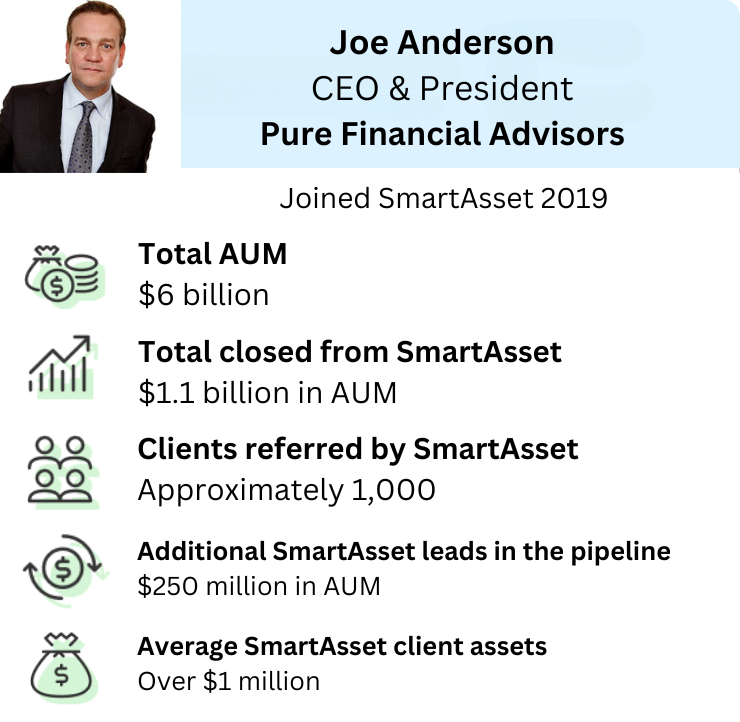 for their target market." width="400" height="200" />
for their target market." width="400" height="200" /> for their target market." width="400" height="200" />
for their target market." width="400" height="200" />
The importance of creating an exceptional client service model can’t be underestimated. Attracting clients – and retaining their loyalty – begins and ends with delivering an experience that not only meets but exceeds their expectations. The most effective client service model for financial advisors is one that emphasizes value while encouraging engagement. Here’s a closer look at how to build one for your practice.
SmartAsset’s Advisor Marketing Platform offers financial advisors services like client lead generation, automated marketing and more. Learn about SmartAsset AMP today.
A client service model is a comprehensive plan or strategy for managing the experience that your clients have while they’re using your services. The experience that a client has when working with you can influence key decisions, such as how much of their assets they’re willing to invest under your guidance and how likely they are to remain with you for the long term.
As new clients come into your business, your client service model can act as a guide for what they should expect. Setting the right tone beginning with the onboarding process is important for ensuring that clients feel not only comfortable but confident in trusting their assets and financial goals to you.
Positive client experiences can lead to higher retention rates, as engaged clients who feel that they’re well taken care of are less likely to look elsewhere for financial advice. Satisfied clients can also help drive new business to your firm if they’re referring you to other investors.
Traditionally, client service models for financial advisors have been built using a segmentation approach. Advisors segment clients into different groups based on assets under management. The underlying services provided to each client segment might be the same, but clients with more AUM might get more one-on-one time with their advisors.
This method has both pros and cons. In terms of positives, it’s easy to implement. You’d simply choose how many segments to include, establish the AUM limits for each one, and then assign clients to a specific tier accordingly based on their net worth.
However, the biggest disadvantage is that this type of service model doesn’t consider what your clients need or value most. Essentially, this model reduces your clients to a number rather than aligning the types of services you provide with the types of services they need. That may be detrimental to them and to you in the long run if they decide to take their business elsewhere because their expectations are not being met.

There’s no single right client service model for financial advisors, as every firm is different. That’s a positive, as you can create a client service model that speaks to the individual needs of your clients and the unique capabilities of your business.
With that in mind, here are four practical tips for perfecting your client service model:
Building a solid service model begins with the client. More specifically, it begins with understanding what’s important to them.
To do this properly, you’ll need to understand your target market and what an ideal client looks like within that market. If you’ve already niched down, this may not be that difficult. But if you haven’t, you may need to consider these types of questions:
The last question is perhaps most important when determining how to segment your service model. If you work with clients who are largely the same demographically or have a similar net worth, then you may choose to operate with a single-segment model. However, if your client base is diverse then it may be necessary to utilize a multi-segment approach in order to ensure that they’re getting the type and degree of attention they need most.
Interviewing or surveying your clients may yield some insights that could help you to better shape your service model. You may ask them questions about their specific experience working with you, as well as questions about positive experiences they’ve had with other businesses in general. This kind of feedback may help you spot flaws or holes in your current service model that are resulting in a less-than-optimal client experience.
As a client moves through different life stages, what they need from you may change. Where they are during any given point in their life cycle as a client can determine the kinds of interactions or advice they seek and how frequently they’re turning to you for help.
A detailed life cycle plan should encompass all the stages that you anticipate a client going through. That can begin with the first contact they make with you. From there, it can include these phases:
Throughout each phase, it’s important to consider any questions, concerns or problems the client might have. Being able to anticipate those types of issues can help you be quicker to address them in a way that’s proactive, rather than reactive.
Consistency matters from a client perspective, as it ties into their overall expectations for your business. That applies to both the interactions they have with you personally, as well as the interactions they have with your staff and with your brand.
A good client service model is designed to promote consistency across all channels. Some examples of what that might look like include:
Technology can play a valuable role in modernizing and enhancing client service models.
For example, you might use a chatbot to answer basic client questions or collect contact information from prospective clients. You may also consider using AI to draft email newsletters and automate their scheduling so that you’re showing up in client inboxes at the same time each week.
Here are some other tech tools to shape your client service model:
Automating tasks can encourage consistency and it can also free up time that you could spend on serving clients. If you’d like to automate lead generation, there’s another tool that can help. SmartAsset AMP helps bring qualified leads to you and equips you with the necessary tools to nurture relationships with prospective clients.

Building a client service model as a financial advisor means knowing what your clients need and how you can best meet those needs. Looking beyond the traditional segmentation model based on AUM can allow you to create a more personalized experience that encourages client engagement and loyalty.
Photo credit: ©iStock/primeimages, ©iStock/Pranithan Chorruangsak, ©iStock/Perawit Boonchu
Rebecca Lake, CEPF®Rebecca Lake is a retirement, investing and estate planning expert who has been writing about personal finance for a decade. Her expertise in the finance niche also extends to home buying, credit cards, banking and small business. She's worked directly with several major financial and insurance brands, including Citibank, Discover and AIG and her writing has appeared online at U.S. News and World Report, CreditCards.com and Investopedia. Rebecca is a graduate of the University of South Carolina and she also attended Charleston Southern University as a graduate student. Originally from central Virginia, she now lives on the North Carolina coast along with her two children. Rebecca also holds the Certified Educator in Personal Finance (CEPF®) designation.
Read More About Advisor Resources



More from SmartAsset
SmartAsset Advisors, LLC ("SmartAsset"), a wholly owned subsidiary of Financial Insight Technology, is registered with the U.S. Securities and Exchange Commission as an investment adviser. SmartAsset's services are limited to referring users to third party advisers registered or chartered as fiduciaries ("Adviser(s)") with a regulatory body in the United States that have elected to participate in our matching platform based on information gathered from users through our online questionnaire. SmartAsset receives compensation from Advisers for our services. SmartAsset does not review the ongoing performance of any Adviser, participate in the management of any user's account by an Adviser or provide advice regarding specific investments.
We do not manage client funds or hold custody of assets, we help users connect with relevant financial advisors.
This is not an offer to buy or sell any security or interest. All investing involves risk, including loss of principal. Working with an adviser may come with potential downsides such as payment of fees (which will reduce returns). There are no guarantees that working with an adviser will yield positive returns. The existence of a fiduciary duty does not prevent the rise of potential conflicts of interest.